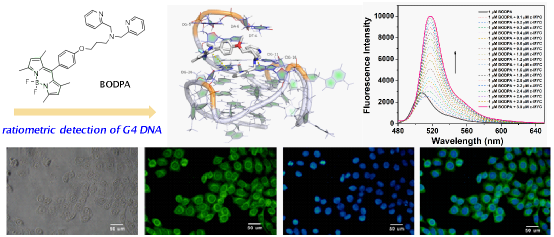Recently, Liu Guangfeng, a 2021 undergraduate student in the Pharmaceutical Engineering program at our institution, published a research paper titled "A Disaggregation-Driven BODPIY-Based Probe for Ratiometric Detection of G4 DNA" as the first author in the international journal Dyes and Pigments. Dyes and Pigments is a Q1 journal in the field of textile dyeing and printing, as ranked by the Chinese Academy of Sciences. The paper's corresponding author is Associate Professor Wang Mingqi, who also served as the guiding mentor.

The development of active recognition systems for biologically important macromolecules has been an important research task in recent years. Among various analytical tools, organic small-molecule fluorescent dyes have received considerable attention due to their unique optical properties, which have the advantages of simple operation and high sensitivity. Compared with the ACQ effect, decomposition is the reverse process of aggregation, in which the aggregated state dissociates into a dispersed state, and the process from aggregation to decomposition usually leads to the recovery or enhancement of fluorescence signals (decomposition-induced luminescence, DIE), which provides a new approach to solve the ACQ problem and to design turn-on probes.The structure of G-quadruplex DNA (G4 DNA), a nonclassical secondary structure of nucleic acids consisting of folded DNA strands rich in tandemly repeated guanines, has been shown to exist stably in living human cells. Real-time imaging of G4 DNAs can provide a more intuitive understanding of their biological functions, as they play an important role in promoting tumourigenesis or proliferation, and have become a novel target for cancer diagnostic and therapeutic research. In this thesis, we designed and synthesised a new BODIPY-based probe, BODPA, with a 2,2′-dipyridylamine moiety for G4 DNA detection. The hydrophilic 2,2′-dipyridylamine moiety not only improved the water solubility of the probe, but also increased the spatial site resistance, which inhibited the aggregation behaviour of the probe in aqueous solution to some extent. The results showed that the free probe BODPA partially formed aggregates, which showed a weak fluorescence emission peak at about 508 nm, whereas an increase in fluorescence at 518 nm was observed for the probe BODPA after the addition of G4 DNA by the DIE mechanism. The fluorescence intensity ratio at 518 and 508 nm (F518/F508) enabled the distinction between G4s and non-G4 topologies, and its binding properties to G4 DNA were investigated using various spectroscopic and docking methods. In addition, the probe was used for live cell imaging. The paper provides ideas for studying ratiometric DIE probes.
This thesis was funded by the Innovation Training Programme for Undergraduates. In recent years, the School of Pharmacy has taken the innovative study as the starting point, attached great importance to the cultivation of students' innovative ability and comprehensive quality of scientific research, and actively promoted and perfected the construction of the “three-pronged education” system.
Link to paper: https://www.sciencedirect.com/science/article/pii/S0143720824001724